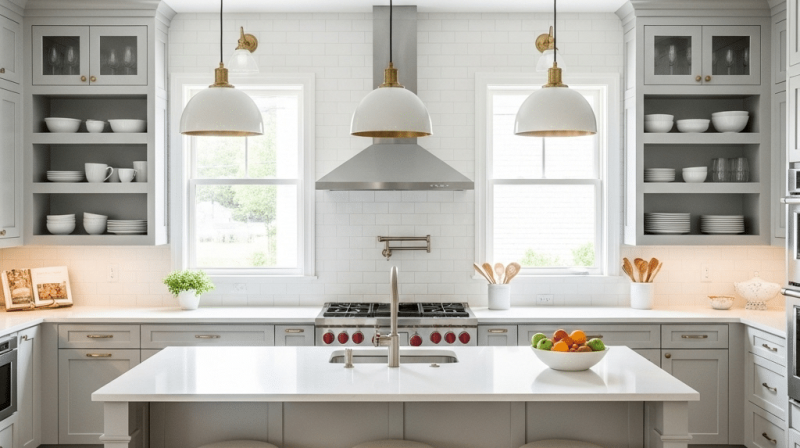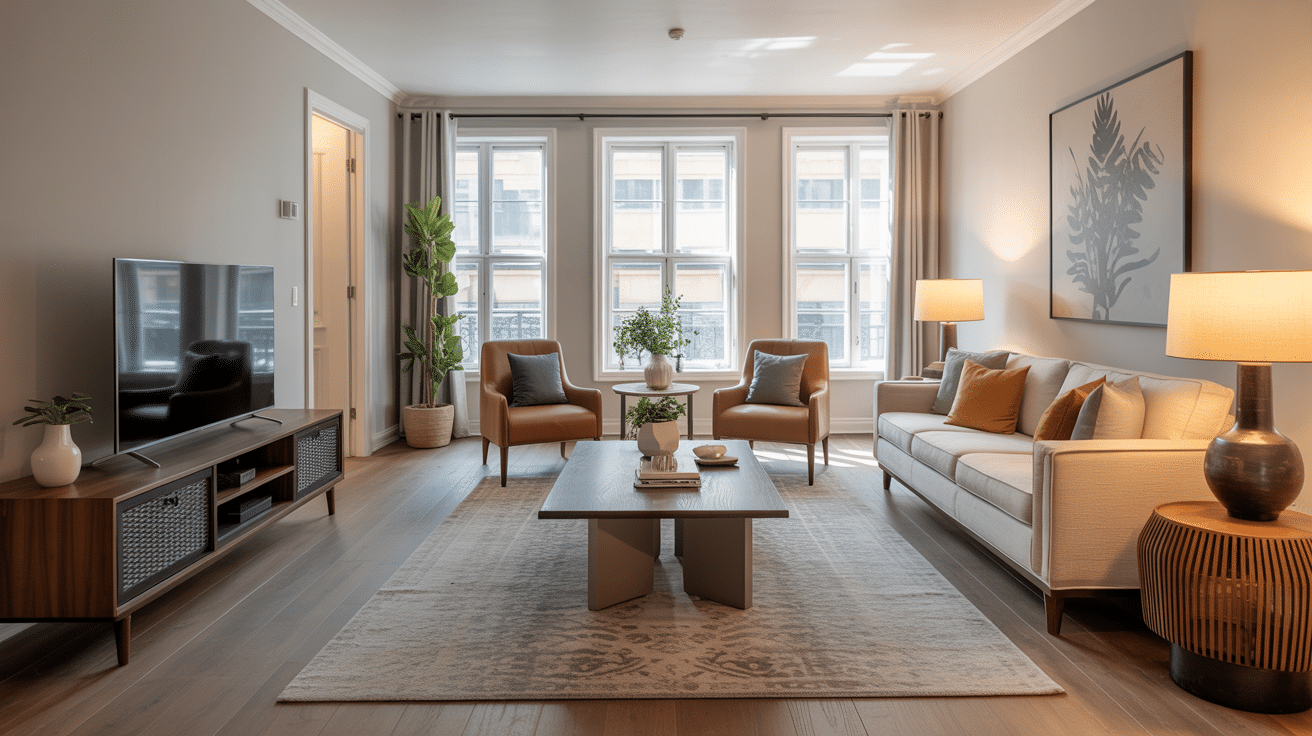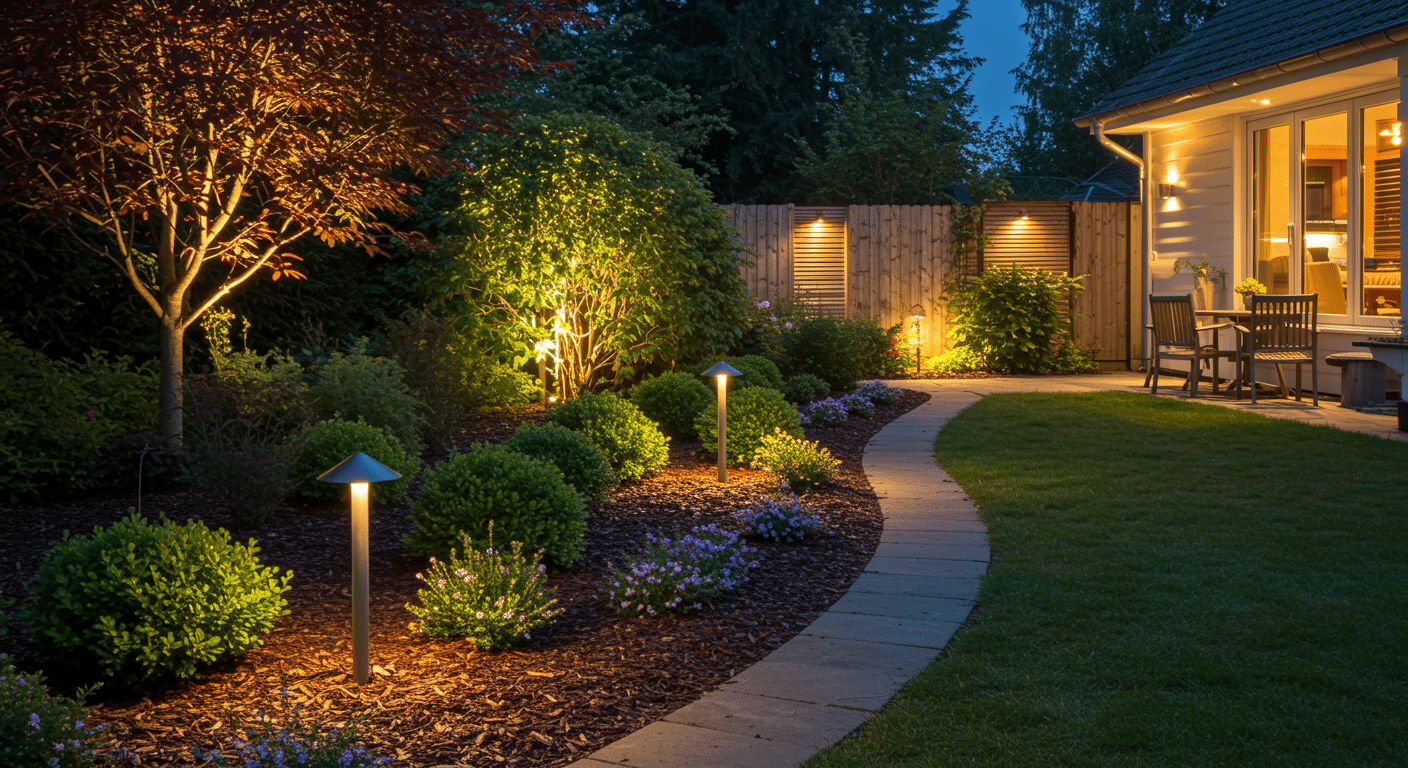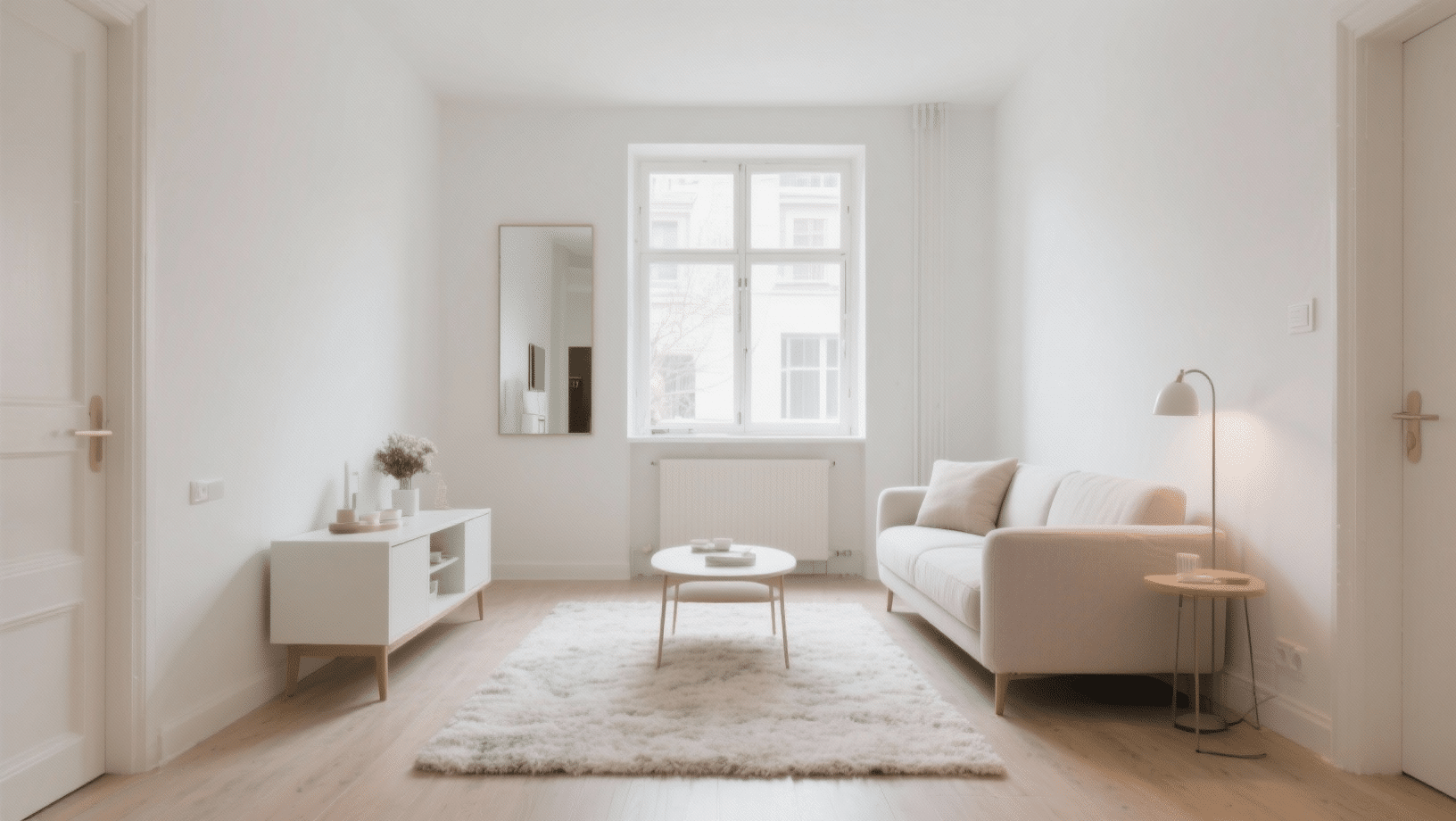Ever walked into a 1950s Cape Cod kitchen and felt trapped in a time capsule?
You’re not alone. Most of these kitchens come with cramped layouts, outdated fixtures, and that closed-off feeling that makes cooking feel like a chore rather than a joy.
I promise you can modify your vintage Cape Cod kitchen into a modern, functional space without losing its classic charm.
This post will show you real before-and-after results, practical renovation strategies, and money-saving tips that helped me turn a dated 1950s kitchen into the heart of the home. Let’s get started on your kitchen makeover.
Key Considerations Before You Remodel
A 1950s Cape Cod kitchen remodel involves striking a balance between traditional charm and modern needs.
Address layout constraints, secure permits, blend new features with vintage style, budget for surprises, and hire a contractor familiar with older Cape Cod quirks.
1. Layout Constraints
- Typical size: 100–120 sq ft.
- Challenge: Small, choppy spaces with load-bearing walls.
- Fix: Remove non-structural walls; add smart storage (cabinets, islands, pantries).
2. Permits & Codes
Always check local permit rules before starting. Expect to update electrical, plumbing, and HVAC to meet modern codes.
3. Modern Needs vs. Vintage Charm
Blend new features (soft-close drawers, modern appliances) with classic looks (Shaker cabinets, beadboard, traditional colors).
4. Budget for Surprises
Set aside 20% extra for hidden issues: old wiring, plumbing, rotted subfloor.
5. Contractor Choice
Hire someone experienced with older Cape Cod homes for unique framing and foundation quirks
Before-and-After Renovations of a Cape Cod Kitchen
A 1950s Cape Cod kitchen remodel delivers dramatic results: brighter, more functional spaces with custom storage, modern finishes, and open layouts.
These before-and-after renovations showcase how smart design choices can double storage, improve flow, and create a timeless, welcoming heart of the home.
Changing Cabinets from Cramped to Custom
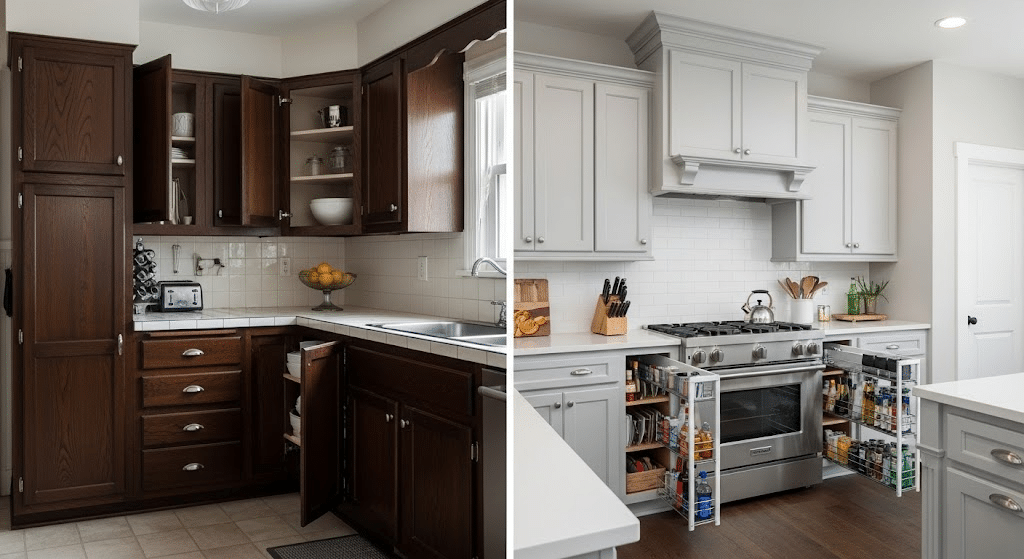
Before: My client’s original 1950s cabinets were dark, stained wood with small doors and limited storage. The heavy grain made the space feel closed-in and dated. Cabinet doors barely opened due to the tight layout, making daily cooking frustrating.
After: We installed light gray cabinets with clean lines and modern hardware. The painted finish brightened the entire space instantly. Adding crown molding gave them a custom look without the custom price tag. Storage capacity doubled with smart interior organizers.
Switch Flooring from Outdated to On-Trend
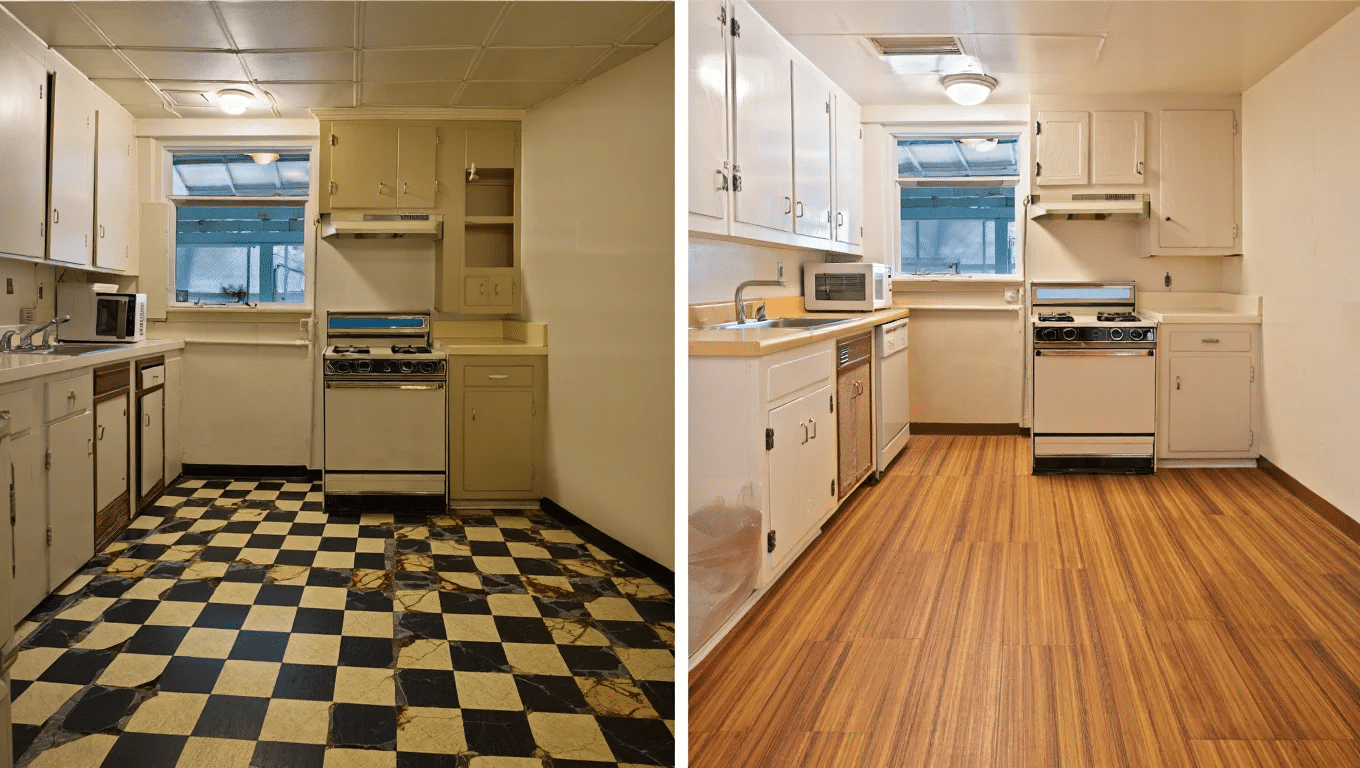
Before: The original black and white checkerboard linoleum was cracked and yellowed with age. It made the small kitchen feel even smaller and showed every speck of dirt. The pattern competed with everything else in the room.
After: We chose wide-plank luxury vinyl that looks like real hardwood. The warm oak tone flows naturally into the living room, creating visual continuity. It’s waterproof, easy to clean, and makes the space feel larger and more cohesive.
Changing Countertops
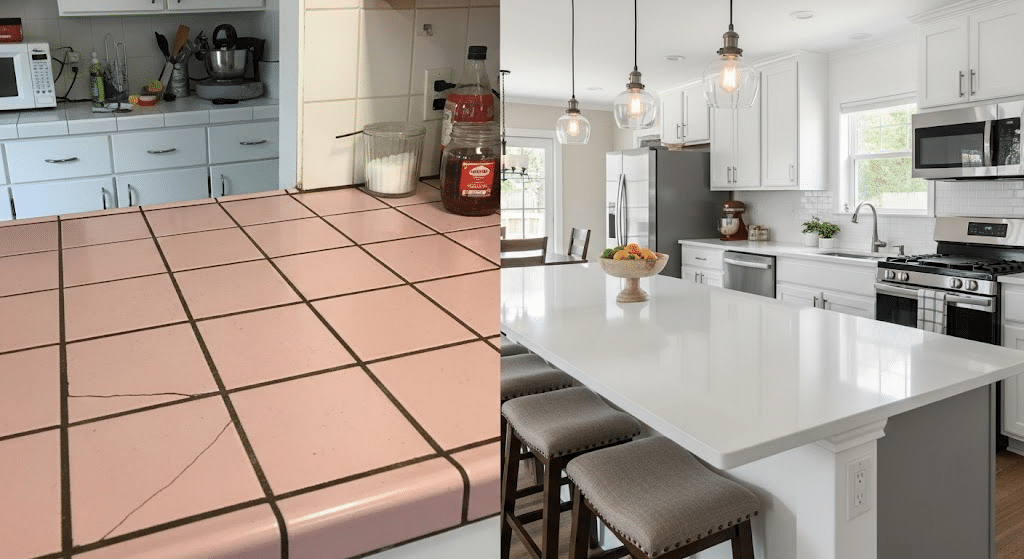
Before: Pink ceramic tile countertops with thick grout lines were impossible to keep clean. The grout had darkened over the decades, and several tiles were cracked or missing. The color clashed with any modern updates we wanted to make.
After: Crisp white quartz countertops updated the workspace completely. The smooth surface is easy to maintain and reflects light beautifully. We extended the counter to create a breakfast bar, adding both function and visual appeal to the kitchen.
Changing Layout by Removing a Wall
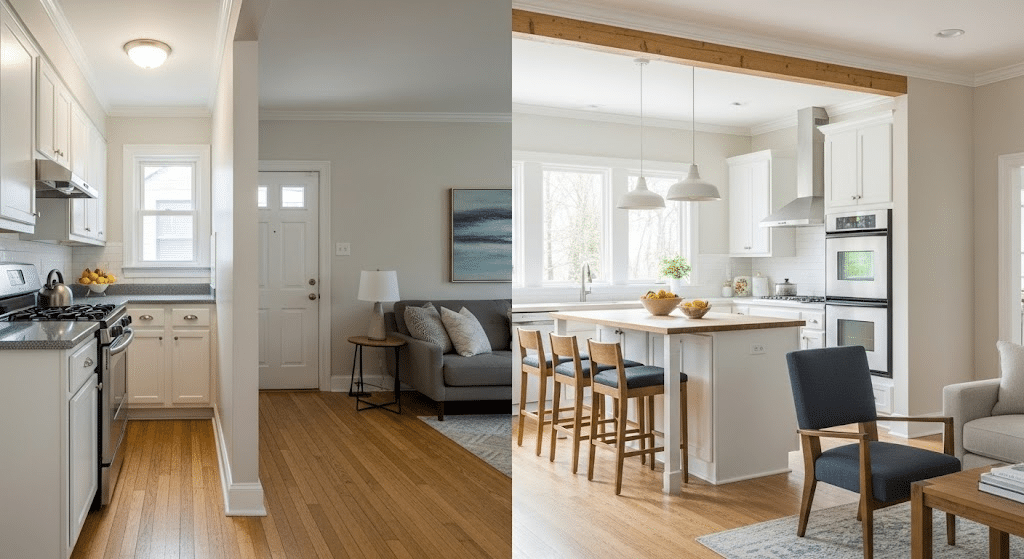
Before: A solid wall separated the kitchen from the living room, creating a cramped galley layout. My client felt isolated while cooking, and the narrow walkway barely fit one person. Natural light couldn’t flow between rooms.
After: Removing the non-load-bearing wall, everything opened up dramatically. We added a peninsula for extra counter space and casual dining. The kitchen now flows into the living area, making the whole first floor feel twice as large.
Adding Finishing Touches
Finishing touches bring warmth and personality to a 1950s Cape Cod kitchen remodel.
Thoughtful color palettes and vintage finds like antique dishware and reclaimed wood blend history with style, creating a space that feels both timeless and uniquely personal.
Color Palettes That Work
| Palette Type | Color Combo | Details |
|---|---|---|
| Key Neutral Combo | Cream + Warm Brass | Cream cabinets with brass hardware |
| Light Gray + Black Iron | Gray cabinets with black iron fixtures | |
| Off-White + Natural Wood | Soft walls with wooden trim or shelves | |
| Popular Combo | Navy + Brass | Rich navy tones paired with classic brass |
| Sage + Cream | Muted sage walls with creamy cabinetry | |
| Winning Color Pair | Navy + Brass + White Marble | Navy cabinets, brass pulls, white marble counters |
| Sage + Cream + Copper | Soft sage walls, cream cabinetry, copper details | |
| Charcoal + White + Gold | Charcoal island, white cabinets, gold hardware |
Styling with Vintage Finds
Adding vintage finds, like antique dishware, reclaimed wood, and original hardware, brings warmth and history to a Cape Cod kitchen.
Estate sales, antique shops, and thrift stores are top sources for authentic 1950s pieces.
Incorporating antique dishware, repurposed wood, and original hardware
I displayed vintage Pyrex bowls and Fire-King dishes in open shelving. Original cabinet pulls get cleaned and reused when possible.
Reclaimed wood becomes floating shelves or cutting board collections that add warmth and history to the space.
Where to find original 1950s pieces
Estate sales offer the best treasures for a 1950s Cape Cod kitchen remodel. I went to local antique shops and flea markets. Online marketplaces are effective, but seeing pieces in person helps you judge quality and originality more accurately.
To Conclude
Your Cape Cod kitchen doesn’t have to stay stuck in the past. I’ve shown you how smart planning, strategic updates, and respect for original character can create a space that works for modern life while honoring vintage charm.
The renovation phase takes patience and the right team, but the results speak for themselves.
I now have a kitchen that’s both functional and beautiful – proof that old homes can adapt without losing their soul.
Ready to start your own 1950s Cape Cod kitchen remodel? Take these ideas, find your trusted contractor, and begin creating the heart of your home.


